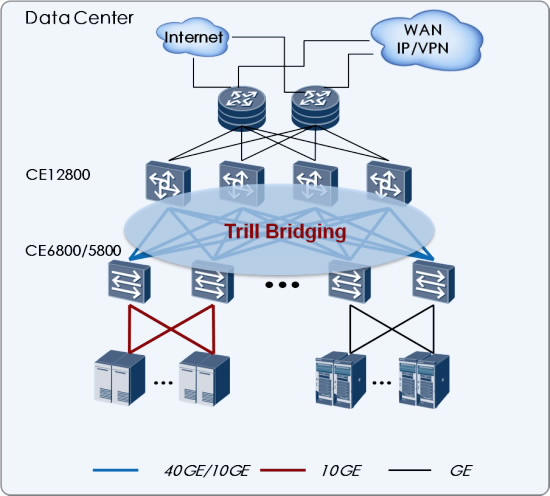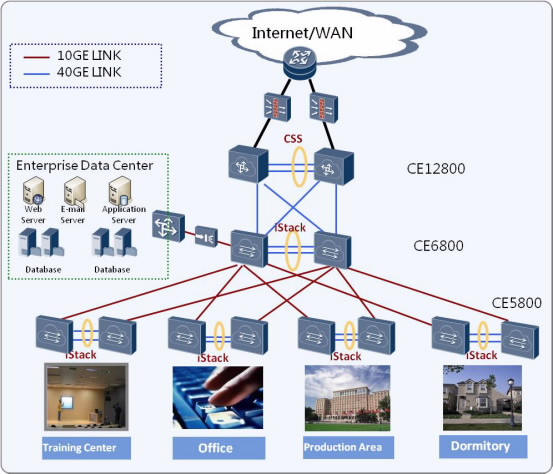The CloudEngine 12800 (CE12800) series switches are next-generation, high-performance core switches designed for data center networks and high-end campus networks. Using Huawei’s next-generation VRP8 software platform, CE12800 series switches provide stable, reliable, secure, and high-performance L2/L3 switching capabilities to help build an elastic, virtualized, and high-quality network.
The CE12800 series switches use advanced hardware architecture design and have the highest performance of any currently available core switches. The CE12800 provides as much as 48 Tbit/s switching capacity and high-density line-speed ports. Each switch has up to 288*40GE, or 1152*10GE ports.
The CE12800 series switches use an industry-leading Clos architecture and provide comprehensive virtualization capabilities along with data center service features. Moreover, the CE12800 switches use innovative energy-saving technologies to greatly reduce power consumption and have a front-to-rear ventilation channel design to provide industrial-grade reliability.
|
Item
|
CE12804
|
CE12808
|
CE12812
|
CE12816
|
|
Total switching capacity |
16 Tbit/s |
32 Tbit/s |
48 Tbit/s |
64 Tbit/s |
|
Total forwarding performance |
4800 Mpps |
9600 Mpps |
14400 Mpps |
19200 Mpps |
|
Service slot quantity |
4 |
8 |
12 |
16 |
|
Device virtualization |
Virtual system (VS) |
|||
|
Cluster switch system (CSS) |
||||
|
Layer 2 multipath protocol |
TRILL |
|||
|
VLAN |
Adding access, trunk, and hybrid interfaces to VLANs |
|||
|
Default VLAN |
||||
|
QinQ |
||||
|
MAC address |
Dynamic learning and aging of MAC addresses |
|||
|
Static, dynamic, and blackhole MAC address entries |
||||
|
Packet filtering based on source MAC addresses |
||||
|
MAC address limiting based on ports and VLANs |
||||
|
STP |
STP, RSTP, and MSTP |
|||
|
BPDU protection, root protection, and loop protection |
||||
|
IP routing |
IPv4 dynamic routing protocols, such as RIP, OSPF, IS-IS,
and BGP |
|||
|
IPv6 dynamic routing protocols, such as, RIPng, OSPFv3,
ISISv6, and BGP4+ |
||||
|
Multicast |
IGMP v1/v2/v3, IGMPv1/v2/v3 snooping |
|||
|
PIM-SM, PIM-SSM |
||||
|
MSDP, MBGP |
||||
|
Multicast VLAN |
||||
|
Prompt leave |
||||
|
Multicast querier |
||||
|
MPLS |
Basic MPLS functions |
|||
|
MPLS VPN/VPLS |
||||
|
Traffic Analysis |
Netstream |
|||
|
Reliability |
LACP |
|||
|
VRRP and BFD for VRRP |
||||
|
BFD for BGP/IS-IS/OSPF/static route |
||||
|
DLDP |
||||
|
In-service software upgrade (ISSU)
|
||||
|
QoS |
Traffic classification based on Layer 2, Layer 3, Layer 4,
and priority information |
|||
|
Actions include ACL, CAR, and re-marking |
||||
|
Queue scheduling modes such as PQ, WFQ, and PQ+WRR |
||||
|
Congestion avoidance mechanisms, including WRED and tail
drop |
||||
|
Traffic shaping |
||||
|
Configuration and maintenance |
Console, Telnet, and SSH terminals
|
|||
|
Network management protocols, such as SNMPv1/v2/v3 |
||||
|
File upload and download through FTP and TFTP |
||||
|
BootROM upgrade and remote upgrade
|
||||
|
Hot patches |
||||
|
User operation logs |
||||
|
Security and management |
RADIUS and HWTACACS authentication for login users |
|||
|
Command line authority control based on user levels, |
||||
|
Defense against MAC address attacks, broadcast storms and
heavy-traffic attacks |
||||
|
Ping and traceroute |
||||
|
Remote network monitoring (RMON) |
||||
|
|
CE12804 |
CE12808 |
CE12812 |
CE12816 |
|
Dimensions (W x D x H) |
442mm×970mm× |
442mm×970mm× |
442mm×970mm× |
442mm×1065mm× |
|
Chassis weight (empty) |
< 75 kg |
< 90 kg |
< 110 kg |
< 192 kg |
|
Operating voltage |
AC: 90 V to 290 V |
|
||
|
Maximum power supply capacity |
5400 W |
10800 W |
16200 W |
27000 W |
On a typical data center network,
CE12800 switches work as core switches and CE6800/CE5800 switches
work as TOR switches. CE6800/CE5800 switches connect to CE12800
switches through 40GE/10GE ports. The CE12800 and CE6800/CE5800
switches use the TRILL protocol to build a non-blocking Layer 2
network, which allows large-scale VM migrations and flexible service
deployments.
Note: The TRILL protocol can also be used on campus networks to
support flexible service deployments in different service areas.

On a typical campus network, two CE12800 switches are virtualized
into a logical core switch using CSS technology. Multiple CE6800
switches at the aggregation layer form a logical switch using iStack
technology. The CSS and iStack technologies improve network
reliability and simplify network management. At the access layer,
CE5800 switches are stacked using iStack technology to provide
high-densities of line-speed ports.
Note: CSS technology is also widely used in data centers to
facilitate network management
